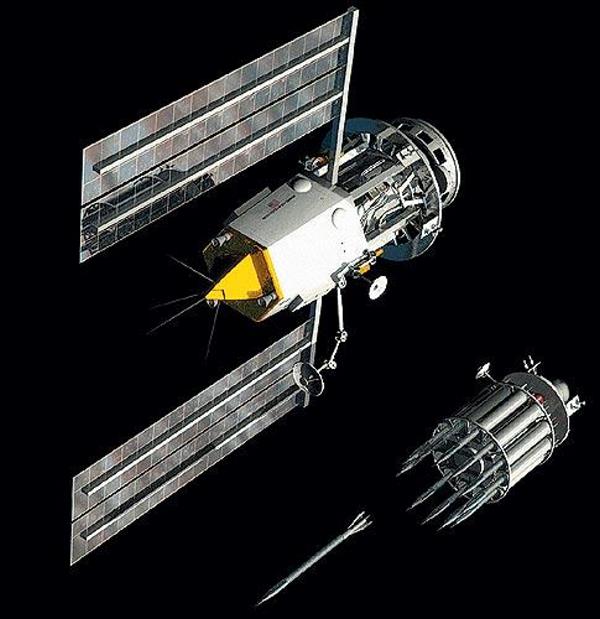|
Star Wars Weapons |
||
|
..
By John Macneill Space-based
weapons have exceptionally disparate advantages and disadvantages: They
are extremely powerful and difficult to defend against, but they’re also
expensive to launch and maintain and they’re in constant motion above the
Earth. John Macneill
Rods from God
This technology is very far out—in miles and years.
A pair of satellites orbiting several hundred miles above the Earth would
serve as a weapons system. One functions as the targeting and communications
platform while the other carries numerous tungsten rods—up to 20 feet in
length and a foot in diameter—that it can drop on targets with less than
15 minutes’ notice. When instructed from the ground, the targeting satellite
commands its partner to drop one of its darts. The guided rods enter the
atmosphere, protected by a thermal coating, traveling at 36,000 feet per
second—comparable to the speed of a meteor. The result: complete devastation
of the target, even if it’s buried deep underground. (The two-platform
configuration permits the weapon to be “reloaded” by just launching a new
set of rods, rather than replacing the entire system.)
The concept of kinetic-energy weapons has been around
ever since the RAND Corporation proposed placing rods on the tips of ICBMs
in the 1950s; the satellite twist was popularized by sci-fi writer Jerry
Pournelle. Though the Pentagon won’t say how far along the research is,
or even confirm that any efforts are underway, the concept persists. The
“U.S. Air Force Transformation Flight Plan,” published by the Air Force
in November 2003, references “hypervelocity rod bundles” in its outline
of future space-based weapons, and in 2002, another report from RAND, “Space
Weapons, Earth Wars,” dedicated entire sections to the technology’s usefulness.
If so-called “Rods from God”—an informal nickname of untraceable origin—ever do materialize, it won’t be for at least 15 years. Launching heavy tungsten rods into space will require substantially cheaper rocket technology than we have today. But there are numerous other obstacles to making such a system work. Pike, of GlobalSecurity.org, argues that the rods’ speed would be so high that they would vaporize on impact, before the rods could penetrate the surface. Furthermore, the “absentee ratio”—the fact that orbiting satellites circle the Earth every 100 minutes and so at any given time might be far from the desired target—would be prohibitive. A better solution, Pike argues, is to pursue the original concept: Place the rods atop intercontinental ballistic missiles, which would slow down enough during the downward part of their trajectory to avoid vaporizing on impact. ICBMs would also be less expensive and, since they’re stationed on Earth, would take less time to reach their targets. “The space-basing people seem to understand the downside of space weapons,” Pike says—among them, high costs and the difficulty of maintaining weapon platforms in orbit. “But I’ll still bet you there’s a lot of classified work on this going on right now.” SOURCE: Popular Science Related Links: |
||
Rods of tungsten, stored on an
orbiting platform [top], would be released to strike buried targets on
Earth. However, each rod would take several minutes to reach its target
and would be difficult to steer, limiting the weapon to attacking fixed
positions. There is also an upper bound on the rods' velocity, which means
their destructive force would be similar to that of cheaper conventional
explosives.
|
||
| FAIR USE NOTICE: This page contains copyrighted material the use of which has not been specifically authorized by the copyright owner. Pegasus Research Consortium distributes this material without profit to those who have expressed a prior interest in receiving the included information for research and educational purposes. We believe this constitutes a fair use of any such copyrighted material as provided for in 17 U.S.C § 107. If you wish to use copyrighted material from this site for purposes of your own that go beyond fair use, you must obtain permission from the copyright owner. | ||
|
|



